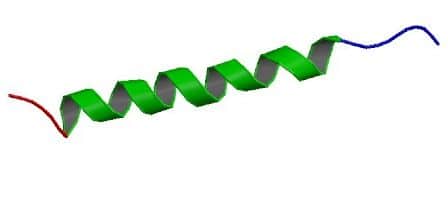Glucagon is the hormone that opposes insulin, so it acts to raise blood glucose levels. It is a peptide hormone produced by the alpha cells of the pancreas.
This article shall consider the structure of glucagon, its synthesis, secretion, mechanism of action and clinical conditions that may result from faults in this process.
Synthesis
A precursor molecule, proglucagon, undergoes post-translational processing to become a biologically active glucagon.
Secretion
Glucagon is secreted by alpha cells in the islets of Langerhans in the tail of the pancreas. Low glucose levels in the blood are detected by alpha cells, stimulating the release of glucagon. Like insulin, this undergoes margination and exocytosis to be released.
Mechanism of Action
Glucagon binds to a specific glucagon receptor in the cell membrane, a G-protein coupled receptor (GPCR). This activates the enzyme adenylate cyclase which increases cAMP intracellularly. This activates protein kinase A which phosphorylates and activates a number of important enzymes in target cells.
Overall Effects
The overall metabolic effects of glucagon are typically exerted on the liver:
- Increased glycogenolysis
- Decreased glycogenesis
- Increased gluconeogenesis
- Increased ketogenesis
It also increases lipolysis in adipose tissue.
Control of Glucagon
| Stimulates secretion | Inhibits secretion |
| Adrenaline | GI tract hormones |
| Noradrenaline | Acetylcholine |
Clinical Relevance – Glucagonoma
A glucagonoma is a tumour of the alpha cells of the pancreas. These tumours lead to the overproduction of glucagon, which can cause a variety of symptoms:
- Hyperglycaemia
- Weight loss
- Anaemia
- Diarrhoea
- Diabetes mellitus
The presenting problem in most cases however, is necrolytic migratory erythema (NME), a red, blistering rash that spreads across the skin. It particularly affects the skin around the mouth and extremities, but can also be found on the lower abdomen, perineum and groin.
A blood serum glucagon of more than 1000pg/mL is indicative of a glucagonoma and the tumour can be localised using radiography such as CT or MRI scans.
Medication that inhibits glucagon release or damages alpha cells in the pancreas can be used to help minimize symptom progression, however the only curative treatment is surgical resection of the tumour.

